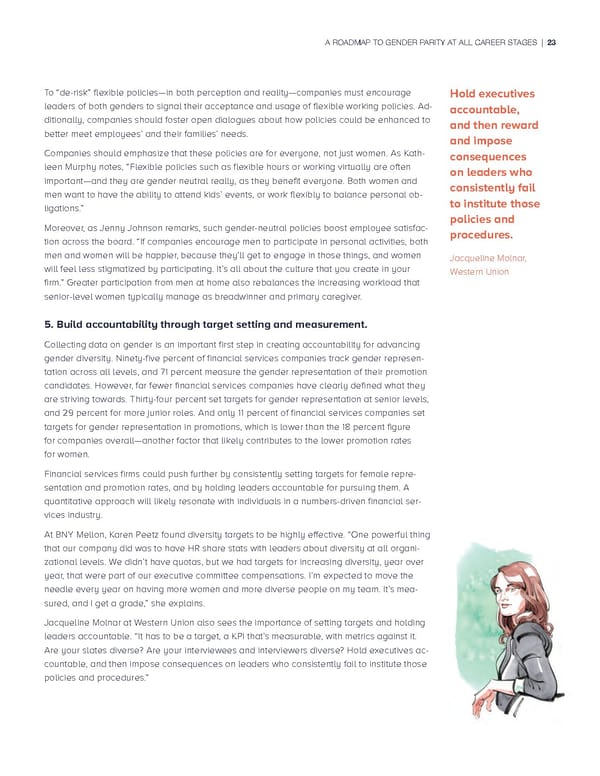A ROADMAP TO GENDER PARITY AT ALL CAREER STAGES | 23 To “de-risk” flexible policies—in both perception and reality—companies must encourage Hold executives leaders of both genders to signal their acceptance and usage of flexible working policies. Ad- accountable, ditionally, companies should foster open dialogues about how policies could be enhanced to and then reward better meet employees’ and their families’ needs. and impose Companies should emphasize that these policies are for everyone, not just women. As Kath- consequences leen Murphy notes, “Flexible policies such as flexible hours or working virtually are often on leaders who important—and they are gender neutral really, as they benefit everyone. Both women and consistently fail men want to have the ability to attend kids’ events, or work flexibly to balance personal ob- to institute those ligations.” policies and Moreover, as Jenny Johnson remarks, such gender-neutral policies boost employee satisfac- procedures. tion across the board. “If companies encourage men to participate in personal activities, both men and women will be happier, because they’ll get to engage in those things, and women Jacqueline Molnar, will feel less stigmatized by participating. It’s all about the culture that you create in your Western Union firm.” Greater participation from men at home also rebalances the increasing workload that senior-level women typically manage as breadwinner and primary caregiver. 5. Build accountability through target setting and measurement. Collecting data on gender is an important first step in creating accountability for advancing gender diversity. Ninety-five percent of financial services companies track gender represen- tation across all levels, and 71 percent measure the gender representation of their promotion candidates. However, far fewer financial services companies have clearly defined what they are striving towards. Thirty-four percent set targets for gender representation at senior levels, and 29 percent for more junior roles. And only 11 percent of financial services companies set targets for gender representation in promotions, which is lower than the 18 percent figure for companies overall—another factor that likely contributes to the lower promotion rates for women. Financial services firms could push further by consistently setting targets for female repre- sentation and promotion rates, and by holding leaders accountable for pursuing them. A quantitative approach will likely resonate with individuals in a numbers-driven financial ser- vices industry. At BNY Mellon, Karen Peetz found diversity targets to be highly effective. “One powerful thing that our company did was to have HR share stats with leaders about diversity at all organi- zational levels. We didn’t have quotas, but we had targets for increasing diversity, year over year, that were part of our executive committee compensations. I’m expected to move the needle every year on having more women and more diverse people on my team. It’s mea- sured, and I get a grade,” she explains. Jacqueline Molnar at Western Union also sees the importance of setting targets and holding leaders accountable. “It has to be a target, a KPI that’s measurable, with metrics against it. Are your slates diverse? Are your interviewees and interviewers diverse? Hold executives ac- countable, and then impose consequences on leaders who consistently fail to institute those policies and procedures.”
 Closing the Gap Page 24 Page 26
Closing the Gap Page 24 Page 26